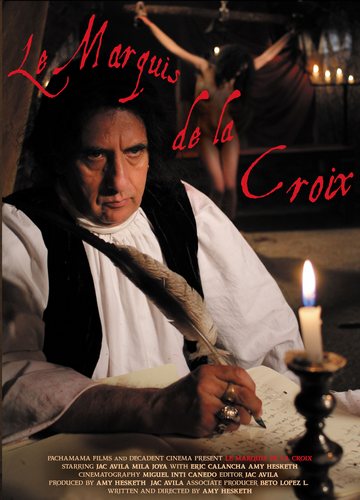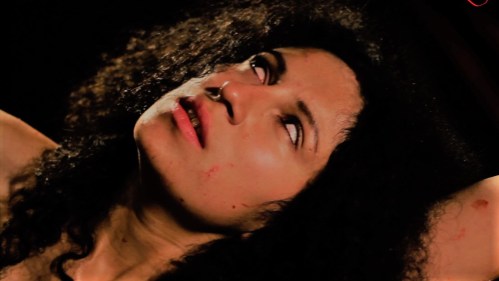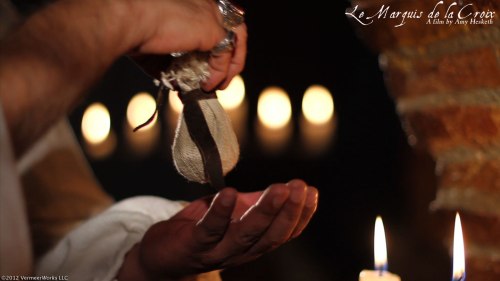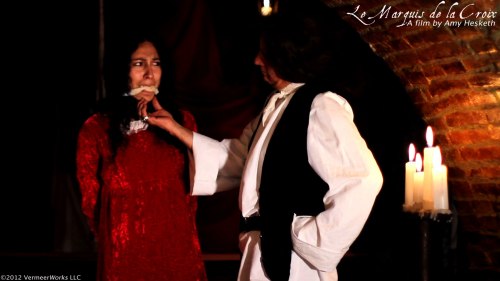by Rich Moreland, April 2017
Le Marquis de la Croix is a film by Amy Hesketh that features Jac Avila and Mila Joya. It is available for download or on DVD from Vermeerworks.
This is the first of a five-part series on the film and combines a review with commentary from Amy and Jac. The final post is exclusive to Mila Joya, the star of the film.
Le Marquis is another provocative work from the collaboration of Amy and Jac. I highly recommend it.
All photos are courtesy of Pachamama Films.
* * *
The Story
The wealthy marquis, sentenced to his prison confines (luxurious as they are), writes lurid accounts of his sexual imaginations. Fortunately for his perverse addictions, an occasional condemned female criminal is brought to him for a price.
Such is the case with Zynga, a gypsy girl sentenced to death, as the marquis tells us, for “three crimes: murder, theft, and arson” (borrowed incidentally from the Marquis de Sade’s 1791 novel, Justine).
 The film explores the tortures Zynga endures and her eventual demise. The story is presented as a narration extracted from the marquis’ writings in his cell. As he completes one torment and plans the next, the aristocrat returns to his desk to record his thoughts and lets the viewer into his mind via voice over.
The film explores the tortures Zynga endures and her eventual demise. The story is presented as a narration extracted from the marquis’ writings in his cell. As he completes one torment and plans the next, the aristocrat returns to his desk to record his thoughts and lets the viewer into his mind via voice over.
The bound and naked Zynga is the consistent background image and the main motif throughout the film.
Strikingly Innovation
Le Marquis de la Croix is a literary fantasy that operates on different levels. On the surface, it has definite appeal to the BDSM community. Heavily sadomasochistic, the whippings and rack scenes are about as exciting as a bondage film gets. It is realism personified.
The film does, however, offer more. There is an engaging political and religious message that is as appropriate today as it was in Sade’s time, the 18th century setting of the narrative.
Told with a modern flavor, the story also hints at the erotic fascinations of a modern tourist who seeks out a museum then confronts her own sexual fantasies in an ending that, as they like to say in commercial media, is priceless.
Clearly, the American tourist lets us know that whims of the Marquis de Sade are more accepted today than ever before and perhaps more fascinating.
As you might have deduced, the film is a story told concurrently by a contemporary museum guide and the marquis’ pen. Whose imagination brings the story to life is always in question as we work through the film.
Clever, strikingly innovative, and beautify filmed, Le Marquis de la Croix highlights the emergence of Mila Joya as an actress. Though she has few lines that are often blunted by the pain of torture, her performance is exemplary.
The native Bolivian uses her physical expression, particularly her eyes, to tempt, seduce, and react to her torturer, who struggles against his own sexual arousal to complete his self-appointed task.
Jac Avila is the story’s creator; Amy Hesketh the film’s director. The pair also produced the film while Miguel Inti Canedo serves as the chief cinematographer. His image making is exceptional. By that I mean this: any number of stills he took could have easily served as the box cover for packaging the movie.
A final caveat before we look into Le Marquis: there is a commentary section available on the DVD that features Amy and Jac. As noted in the intro above, I have referenced their remarks where appropriate in this series of posts.
Back Streets
Le Marquis opens with an American tourist (Amy Hesketh) checking her guidebook for an out-of-the-way museum in the back streets of a contemporary South American city.
Locating her destination, she descends a stairway into an underground cavern that looks much like a dungeon which of course it was centuries ago.
The museum guide (Eric Calancha) is talking with a couple (Jac Avila and Mila Joya) and welcomes the tourist to the group.
He references a cordoned off area that was the Marquis’ cell. The tourist is wide-eyed and fascinated; the couple, probably on an afternoon date, appears mildly interested and, at times, the girl seems cautious, restrained, and perhaps a bit uneasy (setting the viewer up for her transition into the film).
As the guide talks, the camera moves into the cell and the marquis becomes animated but in whose mind–ours, the guide, the couple, or the tourist?–we don’t know.
In period dress, he is writing at his desk, candles provide the light throughout his expansive environs where the film takes place.
The Gypsy
As the guide explains, the nobleman was imprisoned and “because of his wealth, he could buy women . . .”
Brought in by a paid confederate (the second role for Eric Calancha), a gagged and manacled girl appears behind the marquis . . .
“. . . Women who were condemned to die. There was a person who brought him women in exchange for a sum,” the guide says.
The marquis in over voice brings the story into focus. “There are no limits to what I can purchase. Zynga the gypsy . . . was sold to me bound in chains full of fear, hunger and rage.”
The marquis (Jac Avila) drops a small bag of coins in the confederate’s hand and Zynga (Mila Joya) is offered a chance to avoid the guillotine.
But as the money predicts, she will receive a proper scourging and crucifixion for her decision in a political mockery of the Christian faith.
Next we will look at the images and themes of this extraordinary production.
* * *
You can follow Jac Avila:
And Amy Hesketh:














Pingback: Le Marquis, Part One: The Museum |
Pingback: Le Marquis, Part One: The Museum – A Review – Pachamama Films
Enticing scenario for those whose respect & adoration of women likes to entertain contradictory fantasies in mind or practice with consenting play-mates. Looking forward to continuation of this story. Art D.
LikeLike